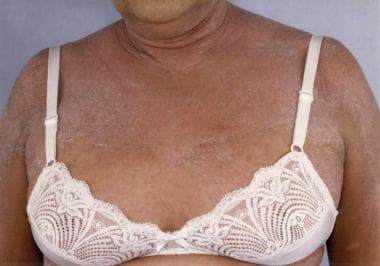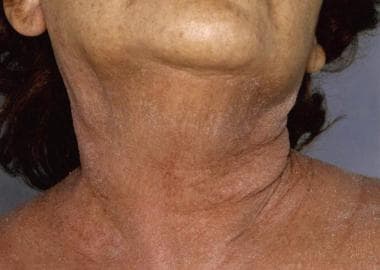Practice Essentials
Erythroderma is a general term used to describe severe, intense skin inflammation; exfoliative dermatitis (ED) refers to a scaling erythematous dermatitis involving 90% or more of the cutaneous surface. Exfoliative dermatitis is characterized by erythema and scaling involving the skin's surface and often obscures the primary lesions that are important clues to understanding the evolution of the disease.
Determining specific etiologies in exfoliative dermatitis (ED) often is not possible; however, it is necessary to attempt since etiology may impact disease course and management options. The list of conditions that can cause exfoliative dermatitis is extensive and continues to expand.
The most common causes of exfoliative dermatitis are best remembered by the mnemonic device ID-SCALP. The causes and their frequencies are as follows [1] :
-
Idiopathic - 30%
-
Drug allergy - 20%
-
Seborrheic dermatitis - 2%
-
Contact dermatitis - 3%
-
Atopic dermatitis - 10%
-
Lymphoma and leukemia - 14%
-
Psoriasis - 20%
Clinicians are challenged to find the cause of exfoliative dermatitis by eliciting the history of illness prior to erythema and scaling, by probing with biopsies, and by performing blood studies. See the images below.
Idiopathic exfoliative dermatitis is characterized by marked palmoplantar keratoderma, dermatopathic lymphadenopathy, and a raised level of serum immunoglobulin E (IgE) and is more likely to persist than other types.
A non-IgE-mediated anaphylactoid adverse event characterized by pruritus, erythroderma, wheezing, flushing, and hypotension following rapid infusion of vancomycin was originally named Red man syndrome (RMS). It has since been reported with oral or topical vancomycin. [2] The use of the term 'red man syndrome' is now discouraged as it leads to underdiagnosis among non-White patients. [3]
In contrast, L'homme rouge historically refers to either idiopathic exfoliative dermatitis or exfoliative dermatitis often secondary to cutaneous T-cell lymphoma (CTCL). Regarding CTCL, it is important to differentiate between indolent and aggressive subtypes, particularly erythrodermic mycosis fungoides and Sézary syndrome, as treatment options differ. [4]
Pathophysiology
An increased skin blood perfusion occurs in exfoliative dermatitis (ED) that results in temperature dysregulation (resulting in heat loss and hypothermia) and possible high-output cardiac failure. The basal metabolic rate rises to compensate for the resultant heat loss. Fluid loss by transpiration is increased in proportion to the basal metabolic rate. The situation is similar to that observed in patients following burns (negative nitrogen balance characterized by edema, hypoalbuminemia, loss of muscle mass).
A marked loss of exfoliated scales occurs that may reach 20-30 g/d. This contributes to the hypoalbuminemia commonly observed in exfoliative dermatitis. Hypoalbuminemia results, in part, from decreased synthesis or increased metabolism of albumin. Edema is a frequent finding, probably resulting from fluid shift into the extracellular spaces. Immune responses may be altered, as evidenced by increased gamma-globulins, increased serum IgE in some cases, eosinophil infiltration, and CD4+ T-cell lymphocytopenia in the absence of HIV infection. Oxidative stress is also associated with drug-induced erythroderma. [5]
Chronic erythroderma in elderly men may represent a unique condition distinct from adult atopic dermatitis. [6]
Etiology
Determining specific etiologies in exfoliative dermatitis (ED) often is not possible; however, it is necessary to attempt since etiology may impact disease course and management options. The list of conditions that can cause exfoliative dermatitis is extensive and continues to expand. Cutaneous diseases that cause exfoliative dermatitis and the systemic diseases associated with them include the following [7, 8, 9] :
-
Atopic dermatitis - Acute and chronic leukemia
-
Contact dermatitis - Reticulum cell sarcoma
-
Dermatophytosis - Carcinoma of rectum
-
Hailey-Hailey disease - Carcinoma of fallopian tubes
-
Leiner disease - Graft versus host disease
-
Lupus erythematosus - Lymphoma (including Hodgkin disease)
-
Mycosis fungoides - Multiple myeloma
-
Pemphigoid - Carcinoma of lung
-
Pemphigus foliaceus - Mycosis fungoides
-
Sarcoid
The most common causes of exfoliative dermatitis are best remembered by the mnemonic device ID-SCALP. The causes and their frequencies are as follows [1] :
-
Idiopathic - 30%
-
Drug allergy - 20%
-
Seborrheic dermatitis - 2%
-
Contact dermatitis - 3%
-
Atopic dermatitis - 10%
-
Lymphoma and leukemia - 14%
-
Psoriasis - 20%
More than 135 drugs have been implicated in the causation of exfoliative dermatitis (see Table 1 below). In many cases of protracted exfoliative dermatitis classified as being of undetermined cause, careful follow-up care and reevaluation implicated atopic dermatitis in older patients, intake of drugs overlooked by the patient, and prelymphomatous eruption as causative factors. It should be noted that psoriasiform erythroderma has been induced by the tumor necrosis factor (TNF)-α inhibitor golimumab. [10]
Table 1. Drugs Implicated in the Causation of Exfoliative Dermatitis (Open Table in a new window)
99mTC-sestamibi [11] |
ACE inhibitors |
Allopurinol |
Aminoglutethimide |
Amiodarone |
Amitriptyline |
Amoxicillin |
Ampicillin |
Angiogenetic inhibitors [12] |
Arsenic |
Aspirin |
Atropine |
Auranofin |
Aurothioglucose |
Barbiturates |
Benactyzine |
Beta-blockers |
Beta carotene |
Bumetanide |
Bupropion |
Butabarbital |
Butalbital |
Captopril |
Carbamazepine |
Carbidopa |
Cephalosporins [13] |
Chloroquine |
Chlorpromazine |
Chlorpropamide |
Cimetidine |
Ciprofloxacin |
Cisplatin |
Clofarabine [14] |
Clofazimine |
Clofibrate |
Co-trimoxazole |
Cromolyn |
Cytarabine |
Dapsone |
Demeclocycline |
Desipramine |
Diazepam |
Diclofenac |
Diflunisal |
Diltiazem |
Doxorubicin |
Doxycycline |
Efavirenz [15] |
Enalapril |
Escitalopram [16] |
Esomeprazole [17] |
Ethambutol [18] |
Etodolac |
Fenofibrate [19] |
Fenoprofen |
Fluconazole |
Fluindione [20] |
Fluoxetine [21] |
Fluphenazine |
Flurbiprofen |
Furosemide |
Gemfibrozil |
Glipizide [23] |
Gold |
|
Griseofulvin |
Hydroxychloroquine |
Imipramine |
Indomethacin |
|
Intravenous immunoglobulin [26] |
Intravesical mitomycin C [27] |
Iodixanol [28] |
Isoniazid |
Isosorbide |
Ketoconazole |
Ketoprofen |
Ketorolac |
Leflunomide [29] |
Lithium |
Meclofenamate |
Mefenamic Acid |
Meprobamate |
Methylphenidate |
|
Midodrine [30] |
Minocycline |
Morphine sulfate [31] |
Nalidixic Acid |
Naproxen |
Nevirapine [32] |
Nitrazepam [23] |
Nifedipine |
Nitrofurantoin |
Nitroglycerin |
Nizatidine |
Norfloxacin |
Omeprazole |
Pantoprazole [33] |
Penicillamine |
Penicillin |
Pentobarbital |
Perphenazine |
Phenobarbital |
Phenothiazines |
Phenylbutazone |
Phenytoin |
Piroxicam |
Primidone |
Prochlorperazine |
Propranolol |
Pyrazinamide [18] |
Pyrazolones |
Quinapril |
Quinidine |
Quinine |
Retinoids |
Rifampin |
Sorafenib [34] |
Streptomycin |
Strontium ranelate [35] |
Sulfadoxine |
Sulfamethoxazole |
Sulfasalazine |
Sulfisoxazole |
Sulfonamides |
Sulfonylureas |
Sulindac |
Terbinafine [36] |
Tetracycline |
Tobramycin |
Tocilizumab [37] |
Trazodone |
Trifluoperazine |
Trimethoprim |
Vancomycin |
Verapamil |
Warfarin [38] |
||
Sarcoidosis-associated erythroderma may demonstrate lichenoid papules as a clue to the diagnosis. [39]
Epidemiology
Age-, sex-, and race-related demographics
Exfoliative dermatitis onset usually occurs in persons older than 40 years, except when the condition results from atopic dermatitis, seborrheic dermatitis, staphylococcal scalded skin syndrome, or a hereditary ichthyosis. Age of onset primarily is related to etiology. [40, 41]
Male-to-female ratio is 2-4:1.
No racial predilection is reported for exfoliative dermatitis.
Prognosis
The prognosis of exfoliative dermatitis depends largely on underlying etiology. The disease course is rapid if it results from drug allergy, lymphoma, leukemia, contact allergens, or staphylococcal scalded skin syndrome. In acute erythroderma, skin failure can be life-threatening and can require treatment in the intensive care unit (ICU). Systemic complications are less frequent in chronic presentations. [1]
A study [42] of pediatric patients (aged < 19 y) found that fever is a poor prognostic marker and may indicate a susceptibility to rapid deterioration. In this group, those with the following characteristics have a higher tendency to develop hypotension:
-
Age ≤ 3 years
-
Ill appearance
-
Vomiting
-
Glucose ≤ 110 mg/dL
-
Calcium ≤ 8.6 mg/dL
-
Platelet count ≤ 300,000/μL
-
Elevated creatinine
-
Polymorphonuclear leukocyte count ≥80%
-
Presence of a focal infection
The risk of toxic shock syndrome is increased especially in children with erythroderma and fever who have the following additional features: age of 3 years or younger, ill appearance, elevated creatinine value, and hypotension upon arrival.
The disease course is gradual if it results from generalized spread of a primary skin disease (eg, psoriasis, atopic dermatitis).
The mean duration of illness typically is 5 years, with a median of 10 months.
Mortality varies according to the disease's cause. In a study of 91 of 102 patients with exfoliative dermatitis by Sigurdsson et al, [43] a mortality of 43% was observed. Only 18% of the deaths were directly related to exfoliative dermatitis. In 74% of the deaths, causes unrelated to exfoliative dermatitis were implicated.
Patient Education
Educate patients on the specifics of the underlying cause of their exfoliative dermatitis and the importance of diligent follow-up management as indicated. Patients should be educated on the benefits of a healthy lifestyle and to immediately treat occurrences of erythroderma to better manage their diseases in the long term. Patients should be advised to avoid the use of and/or contact with of irritant soaps, lotions, detergents, and chlorine, and special considerations should be made for allergies, especially for patients with atopic dermatitis. [44] Excessive sweating should also be avoided.
For patient education resources, see Skin Conditions & Beauty Center and Life-Threatening Skin Rashes
-
Exfoliative dermatitis diffuse skin involvement.
-
Exfoliative dermatitis close-up view showing erythema and scaling.











